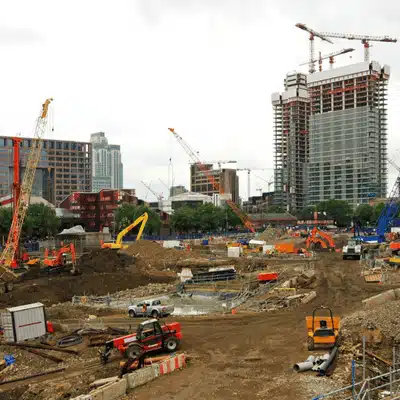
Rework is a problem no contractor wants to face. It means doing work over because it wasn't right the first time. This wastes money, kills schedules, and frustrates everyone on site.
The construction industry loses over $65 billion each year to rework. That's money spent tearing out and fixing work that should have been correct from the start. On average, rework adds 5% to project costs. In bad cases, it can eat up 25% of your budget.
This guide covers what causes rework and how to stop it before it starts.

Rework hits your wallet hard. Construction rework statistics show it typically costs 5% to 9% of total project costs. Some construction firms see their annual profits drop by 28% because of construction rework over several years.
Money isn't the only problem. Schedule delays pile up fast when crews redo work. Every hour spent fixing mistakes is an hour not moving forward. This creates a chain reaction across all trades.
Rework also causes project delays that anger clients and damage reputations. Workers get frustrated doing the same job twice. Safety risks increase when teams rush repairs. Contract disputes arise over who pays for fixes.
The bottom line? Construction rework challenges drain productivity, profits, and time from every project. This productivity loss and cost overruns affect the entire construction industry.
Understanding rework causes is the first step to stopping them. Most construction errors come from a few key areas.
Up to 70% of rework begins in the design phase. Incomplete plans, unclear drawings, and design errors create problems that show up during construction. When specs are wrong or missing, crews build it wrong and must tear it out.
Late design changes force teams to redo completed work. A wall gets framed, then the owner wants it moved. That's automatic rework.
An industry report found 52% of rework comes from bad communication and poor data. When the architect, engineer, and contractor aren't aligned, mistakes happen.
A crew builds from outdated plans because nobody told them about changes. A sub misreads the specs. Trades clash because nobody coordinated their work. These construction errors are all preventable with better communication. Miscommunication between teams creates most avoidable rework.

Poor workmanship causes obvious construction defects. When concrete gets poured wrong or connections get installed poorly, it fails inspection. The work must be redone.
This often happens when workers lack training or supervision. Rushing jobs also creates quality issues that need fixing later. Low workmanship standards guarantee construction defects.
Projects with poor project planning face more rework. When you skip site prep, ignore real conditions, or create unrealistic schedules, mistakes follow.
Time pressure forces crews to work out of sequence. This virtually guarantees errors that become expensive fixes.
Change orders issued mid-project often require removing finished work. While some changes can't be avoided, too many create chaos. Each change ripples through the project timeline and increases rework risk.
The good news? Rework is preventable. Smart firms now run formal rework reduction programs to build it right the first time. These rework reduction programs focus on root causes rather than just fixing symptoms.
The best rework prevention starts before the construction phase begins. Spend real time on design and planning.
Use Building Information Modeling to catch conflicts early. Studies show BIM can cut rework costs by 40% to 50%. Run clash detection on your models. Review specs with all stakeholders.
Fix problems on paper, not in the field. Verify site conditions before you break ground. A solid foundation of project execution planning prevents most rework.
Since bad communication drives so much rework, fixing it pays huge returns. Keep everyone working from current drawings and specs.
Use construction software like Procore or similar platforms to centralize documents. When changes happen, push them to all trades instantly. Hold daily coordination meetings. Create a culture where asking questions is normal.
Teams with strong communication see major productivity gains. Break down information silos and watch rework drop.
Quality control measures are your first defense. Inspect work at key milestones before moving forward. Catch problems when they're cheap to fix.
The Construction Quality Executives Council recommends defining clear quality standards upfront. Train everyone on what meets your standards. Don't leave "good enough" open to interpretation.
Firms without formal quality assurance programs face more construction defects. Don't skip this step. Strong quality management systems prevent rework before it starts.
Modern Tools That Prevent Construction Rework
Catch design conflicts before construction starts. Run clash detection on 3D models to find problems on paper instead of in the field.
40-50% Cost ReductionVerify as-built work matches plans instantly. Monitor quality in hard-to-reach areas and catch errors early when they're cheap to fix.
Real-Time Quality ChecksReport issues instantly with photos. Log defects before they spread. Track punch lists and assign fixes in real time from anywhere on site.
Instant Problem TrackingKeep everyone working from current drawings. Push changes to all trades instantly. Centralize documents so outdated plans never cause rework.
Zero Communication GapsPerform repetitive tasks with machine precision. Eliminate human error in certain activities. Ensure consistent quality on every installation.
Perfect ConsistencyStart using construction software and modern tools today to protect your bottom line.
Modern construction technology helps prevent mistakes. Use laser scanning to verify work matches plans. Deploy drones to monitor hard-to-reach areas.
Mobile apps let crews report issues instantly with photos. Problems get fixed before they spread. Construction management software improves coordination and reduces changes by up to 32%.
Digital tools give you transparency and control. Construction software creates audit trails useful for construction defect resolution if needed. These construction software solutions streamline the construction process and reduce errors. More construction software adoption means fewer construction errors across construction projects.
You can't eliminate all changes, but you can manage them better. Review every change for impacts before approving it. Then share it clearly with everyone.
Track every incident through rework tracking systems. Note what happened, why it happened, and how you fixed it. This reveals patterns over time.
Maybe one sub keeps causing problems. Maybe waterproofing always needs redoing. These insights drive your efforts forward. Hold lessons learned meetings after projects. Turn mistakes into knowledge that prevents future problems.
Successful construction practices combine planning, communication, and quality. Add in construction software and continuous improvement.
Projects following these best practices see construction defects drop dramatically. Some cut construction costs from rework nearly in half. These best practices improve project efficiency across all construction projects.
The Construction Industry Development Board and research groups confirm these approaches work. They reduce delays, prevent overruns, and boost results. Better construction scheduling and project management also help limit rework during project execution.

Stop accepting construction rework as normal. Your projects deserve better. Your profits depend on it.
Implement these rework prevention strategies today. Start with one area like quality control measures or better communication. Build from there.
Ready to eliminate construction rework from your projects? Contact us and start identifying your biggest problem areas this week. Your bottom line will thank you.
Rework typically adds 5% to 9% of total costs. In severe cases, it can reach 25%. The industry wastes over $65 billion annually on rework, making it a major source of loss and schedule delays across all projects.
The primary causes include errors and late changes (causing 70% of issues), poor communication between teams, low quality, weak planning, and changes during the construction process. Most challenges stem from problems in either design or execution phases.
Construction software centralizes documents, tracks changes instantly, and improves team coordination. Studies show integrated tools can reduce changes by 32% and improve adherence by 50%. These tools prevent the bad information that leads to errors.
Control measures involve inspections and testing during work to catch construction defects early. Assurance happens upfront through training teams on standards and defining clear criteria. Together, they form a system that prevents defects rather than just finding them after they occur.